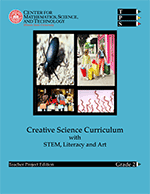Second Grade Science
Book Info

It's a Worm's Life
Although the thought of growing meal worms might not be all that appealing, they work very well for this science activity. They are readily available, very inexpensive, and move through an observable life cycle relatively quickly and successfully. You might like to obtain your mealworms a couple of weeks in advance, remove them from the cool refrigerator, so that more of them will have progressed further through their lifecycle before you begin, and they will be ready to form pupae and become adults more quickly. The pupa (or most dormant stage is likely to last about a week, so if you start with relatively mature larvae, then you could get to adults emerging in less than 2 weeks.
Let It Rain
In this learning cycle, students make a closed system that demonstrates the water cycle. A small "pond" is formed at the bottom of a "hill." The water is caused to evaporate by a small lamp. The water vapor condenses on the plastic top and drip onto the hillside. Since the slope is made of sand, the water droplets make trails down the slope on their way back to the pond. The sand is mixed with powered drink mix, so the water picks up a slight color, similar to minerals picked up by water in a river. Although color in the pond will soon become noticeable, the "rain drops" will remain clear.
Window Shopping
In this learning cycle, students experience the scientific inquiry method as they explore how forces and motion interact. Careful attention to recording data is important. They also work on physical properties of paper structures, magnets to control movement, and marbles rolling and sliding down ramps. They then apply their knowledge as they design and build a window display.
Making Music
In this lesson, students will be building and playing a tubulum. It is a set of pipes that make notes when hit with a rubber paddle. Inform the music teacher that you will be conducting this activity. He/she will be very interested, perhaps offering to participant in teaching the class or incorporate the instrument into their next concert. Cross disciplinary cooperation is always a good idea, but difficult to achieve due to differing educational objectives and tight schedules. This activity clearly addresses science, mathematics, and music.